By Katya Mendoza / El Inde
Beyond two large glass doors that read “SLIDE”, towards the back of a private dining room with white wallpaper that has a cartoon pattern of celebrities like Marilyn Monroe, David Bowie and Tupac Shakur, is a small office space in the back of the Tucson-based restaurant, Culinary Dropout. A room with exposed cinder block, black-wired storage shelves loaded with white porcelain plate ware, black soap-stone tiles organized in a rainbow-colored plastic storage tower and white-long sleeved event attire that hangs from a silver traveling garment rack. A honey skin toned man in his mid-thirties wearing an olive-green fedora that has a tan leather strap on top of a hunter green hatband sits in front of a double-screen computer system.
On any given weekday, Alain Garcia, 36, is answering calls from an office phone that seems to ring on a sequenced loop, the red flashing button signals multiple lines in use throughout the 19,000 square foot restaurant. His right hand rests on top of a palm-sized mouse while his index finger clicks back and forth from outlook emails to excel spreadsheets.
I sit to his left in a black leather office chair as he pulls up another set of spreadsheets up on the screens in which his soft brown eyes zero-in on, displaying images of neutral-colored fedora prototypes. The hats feature embroidered patterns, velvet bows, pheasant feathers and irregular turquoise stones. When Garcia is not creating event proposals, communicating with guests or arranging event services, he designs luxury hats in his free time.
The special events coordinator for the local Fox Restaurant Concept, Garcia is also the owner and creative designer of House of Hatters, a local hat shop that specializes in handcrafted fedoras decorated with sustainably sourced stitch-stones, feathers and adjustable inner drawstrings that offer a custom-made feel. From the wheelhouse studio of his east-side abode, Garcia has pulled colorful inspiration from his worldly adventures ranging from Cartagena, Colombia, San Miguel de Allende, Mexico, and the Yucatán Peninsula of Tulum and currently, his city of Tucson, Arizona.
“My dad always wore hats,” Garcia said.
His father, a lawyer that would dress up like a cowboy on the weekends, worked their family ranch in Sonora, Mexico. Garcia received his first hat when he was six years old, it was identical to his father’s light tan, 12X-Stetson. In his words, “A really good hat.”
An architect by trade, Garcia has always had an aptitude for creative fields. Dabbling between urbanism, interior design and event-planning, Garcia’s studies and passions have taken him to extraordinary cities and schools from Monterrey to San Francisco, ultimately ending up at a wellness ranch in Sonoita. Around that same time seven years ago, his father passed.
“I knew that my job there had an expiration date, I knew that they were going to ask me to stay, but I was going to decline. And I knew that in the next six months I needed to think of what was my next move so I was like, ‘You know what? I think I want to design hats.’ I started designing them on AutoCAD and a couple of other programs. Then I think a trip to Ecuador, met with two factories and one of them was the golden one.” Thus, the inception of House of Hatters.
Within six months, Garcia developed his first prototype. The “Arabella,” a red center dent, wide brim, cotton and polyester fedora, embellished with a jam-colored waxed denim hatband, a brass “Escapulario” cross pendant and turquoise hand-stitched “Parroquia” motif, named after his mother.
Due to global travel restrictions because of the pandemic last year, Garcia was unable to take his usual “work” trip outside of the country, let alone crossing state lines so Garcia began taking little road trips around Arizona to get his creative juices flowing, focusing on the grounding aesthetic of the Southwest.
Garcia’s artistic process is reflective of his mother’s traveling style. “We love food, we love exploring, we’re never in the hotel, we both have our cameras,” Garcia said. Still, today it is hard to imagine flight confirmations and visas, foreign ocean waves with piercing blue waters, cobble-stoned streets reminiscent of centuries old architecture, hand-crafted textiles of the brightest magentas, sizzling food on black cast-iron skillets and the milky sweet scent of coconuts.
“The times dictated what I should do. I couldn’t travel, I wasn’t going to not make a collection,” Garcia said, his head shaking at the ridiculousness of the notion of slowing down even during a global pandemic.
Inspiration was hard to find this past year, artists were unable to walk through plant nurseries nor take meditative walks through local hiking trails that were approaching capacity. Additionally, the only traveling to do was done virtually via Zoom happy hours with distant friends or relatives. The second alternative was late afternoon sunset strolls to beat the sweltering heat. Local artists have overcome more obstacles than one, a year after the shutdown.
Garcia began reaching out to local artists last December, in his words “very bad timing” given the holidays. Out of 20, 7 responded. He embarked on an innovative and virtual venture with the 7 whose work varied in mediums such as macrame, installation art, graphic design, polymer clay and more. Aside from gathering at local markets, bazaars and pop-up events, a local collaboration of this magnitude has never been done before.
“I did not think I was going to make it during this time,” Garcia said. “It’s so much pressure, it’s where I’m from. It’s where I live.”
I sat down with several of the artists to ask about their tentative projects amid our shared journey towards normalcy.
One of his collaborators is a mutual coworker and bartender at Culinary Dropout. Edna Alejandra Bernal Olmedo, 30, is a macrame artist that specializes in custom plant hangers. What began as a hobby turned side hustle after being furloughed last year during the shutdown, in late-August of 2020, she launched her online shop, Studio Ocotillo. Olmedo weaves traditional bohemian cream-colored cords with her own “moody-modern” spin, braiding stormy grays, sage greens, shadow blacks and terracotta reds into her work.
In addition to hardships such as the lack of commissions and income brought on by the pandemic, changing algorithms on social media can cause minor setbacks for local artists. Artists have had to navigate the financial aspect of their businesses, pushing off the leaping decisions of moving to their work full-time. Garcia calls it a “money game,” as he has been studying the fluctuating trends of hat purchases, hoping to switch over to his craft full-time after 2021.
Finding a similar sense of comfort among pastel-colored succulents, emerald pathos plants and sage agaves, Trevor Mock, 28, a visual artist and creator of Sonoran Witch Boy works within the magical realm of fungi, using an acrylic paint medium on recycled glass window panes. A native Tucsonan with a strong background in botanical history and experience of working in an herbarium, Mock’s unique style is sourced by idyllic desert tones. Mock has breached his comfort zone for this project, sketching illustrations of animalia for Garcia’s collaboration, meshing his scientific style.
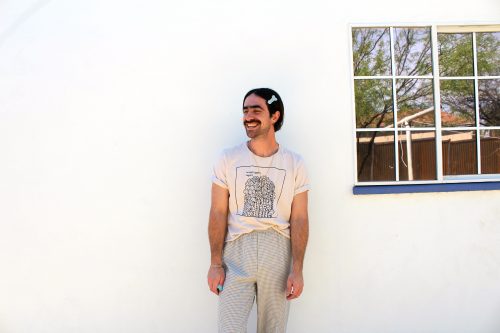
designs printed on it. Photo by Katya Mendoza/El Inde.
“I think it helps kind of reinvigorate our creative energy and makes us do things that we wouldn’t normally do just on our own. I think it also helps us to kind of broaden our markets and our audience… It is always challenging because you have to kind of mix two creative minds that may not always work well together,” Mock said.
Looking forward to the days of gathering all in one place, Mock is excited to see his fellow artists’ work. In addition to the physicality of art, these local artisans are still small-business owners. As an upward trend, the route for exposure in place of local markets are social media giveaways. Creating content is a part of the process. Local creators such as Mock and
Kelsi Somers, 34, a hand-lettering artist and creator of Selah & Bloom have gotten crafty in uplifting each other through the idea of “giveaway loops” and socially distant pop-ups.
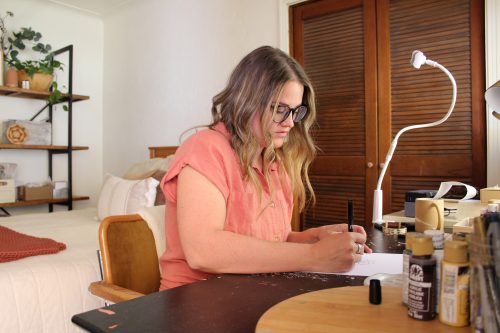
Somers works with hand lettering and watercolors.
Photo by Katya Mendoza/El Inde.
Somers has uncovered newfound camaraderie brought on by the pandemic, finding inspiration from the cathartic processing of life during a global crisis.
“I think there’s been this shared heartbeat of like, ‘Why do I do what I do? Why do I love what I do?’ I think it’s made a lot of us really internally reflective and probably given us more margin to be creative because we have the space to do it. So, coming up with new things, new concepts. I think that’s definitely a shared theme for a lot of us,” Somers said.
Somers completed five sketches of watercolor and linework design for Garcia, admiring the artistic freedom within the collaboration. In her words, this project is a chance to, “physically wear desert magic on our heads.” Recognizing the importance and sustainability of locally sourced materials, the local artisans prioritize the ethics behind eco-friendly materials.
Rachel Rose, 39, a graphic designer and creator of Juju & Moxie Design Co. has taken this time to switch her products to compostable packaging. The plastic sleeves that her vinyl stickers slide into are made of a vegetable cellophane that, if composted, will help things grow. Working on a revamping process of sorts, the search for new avenues of sourcing materials is an ongoing process.
House of Hatters works towards being green as well. Between ethically sourced turkey feathers found in the grasslands of Sonoita to reused packaging materials, Garcia says smaller businesses have better opportunities for being environmentally conscious.
“Whenever you buy a hat, you’ll see that we have a stamp on the inside of the box that says, ‘Do not judge a box by its cover’ because we reuse shipping materials,” Garcia said.
In theory, when supporting local artisans, one should wonder how they go about their production practices behind closed doors and their capacity for long-term sustainability. These local artists’ ethics in practice reflect a sense of gratitude towards the preservation of their shared muse–the planet. After speaking with these artists, I felt the exuberant sense of camaraderie and mindfulness practiced by these unique individuals. Sentiments many have struggled to experience after this past year. It is quite a sight to see the support for each other, even though they’re practically all strangers. The Tucson art realm is extraordinary and a common joke is the size of Tucson. Everyone knows someone who knows someone. A common awareness of one’s choices having the capability of affecting someone else. Like Rose, the community finds value in the practice of grassroots networking and the championing of fellow artists and makers.
“I think it’s really neat for people who maybe are really into hats, for him to bring in some people that they would never even venture to look at. The collaboration helps open up windows and doors for our community and for other artists to see what’s happening and vice versa,” Rose said. Giving some previous illustrations a refresh for the collaboration, Rose’s work offers a funky spin on Mexican folklore. Seeking inspiration from the quirkiness of Tucson architecture in the San Clemente neighborhood and its illustrious sunsets’ diverse color palette, she believes this collaboration has brought a breath of life into the local art base.
Garcia and I slouch in our swivel office chairs, facing each other with relaxed body language. The idea of waiting on others to deliver their sketches is stressful, but Garcia is empathetic to each individual’s artistic process. Usually at this point of a collection, Garcia would have all of his hat models scaled out on his online design program, ready to order physical prototypes. I ask him about the other collaborators within the project to which he responds, Scout Dunbar, Fiona Felix of Dusty Moon Studio, Lauren Valenzuela of Sigfús Designs and Nikki Berger Martinez of Shadow and Growth.
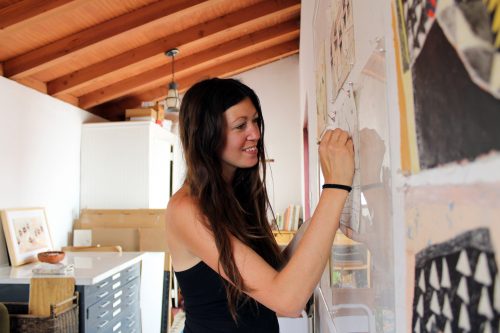
Dunbar creates southwestern inspired prints. Photo by Katya Mendoza/El Inde.
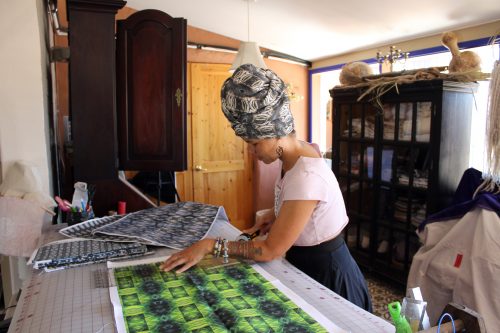
Her prints are of her own photography. Photo by Katya Mendoza/El Inde.
“It does kind of weave us together and the community too. I think that someone that would be a fan of Sigfús for example, wouldn’t be a fan of mine and now we’re kind of partnering. So it expands your clientele… It’s cool to see a design that’s merged by two artists,” Garcia said.
Garcia’s work has been featured in GQ, British Vogue and the Condé Nast Traveler. House of Hatter’s hats are outsourced from skilled milliners from Ecuador, the accessory elements are sent in by artisans from a variety of locations. As he pulls up the final list of eight Tucson artists, he tells me about the variety of mediums and unique styles each studio utilizes. His half of the prototypes are mostly finished, illustrating familiar tones of rocky desert sand, mauve pinks, sage greens and midnight blues. While the Sonoran Desert landscape is mysterious and unforgiving, it speaks to its inhabitants if they choose to listen closely. The “Tucson Collection,” is an ode to its dwellers, offering them the chance to wear its desert magic on their heads.
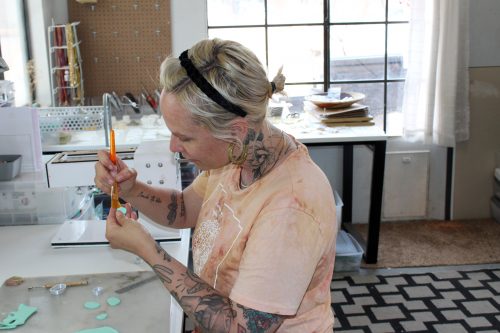
Valenzuela works with various mediums including polymer clay.
Photo by Katya Mendoza/El Inde.
